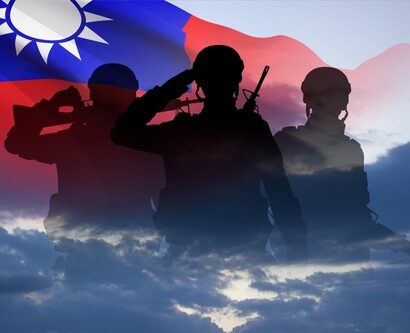Abstract: This article examines the growing potential for confrontation between the People’s Republic of China (PRC) and Taiwan, fueled by Beijing’s strategy to isolate its neighbour through an intricate array of military, economic, and diplomatic coercion. It considers this part of Beijing’s larger goal to erode the regional superiority enjoyed by Washington in East Asia — with a particular focus on territorial claims, such as those being made in the South China Sea, which translate into hybrid expansion strategies, including the construction of artificial islands.
Problem statement: How are the PRC’s increasing efforts to isolate Taiwan endangering global stability, and what policies can the U.S.?
So what?: Western allies, chiefly among them relevant stakeholders such as France and the United States, ought to significantly enhance both their conventional and hybrid deterrence assets while simultaneously heavily investing in defence procurement. The expansion of multilateral defence cooperation in the Indo-Pacific region to safeguard both global stability and their strategic interests by boosting Taiwan’s security capacities from Chinese encroachment.

Source: shutterstock.com/FOTOGRIN
Isolating Taiwan
Following decades of tedious democratisation that succeeded a military dictatorship imposed by the nationalist Kuomintang (KMT), 2016 saw a significant shift in paradigms as Taiwan’s Democratic Progressive Party (DPP) took over the reins of power on the island state. Prior to this, the publication of three “joint communiqués” in 1972, 1978, and 1982 laid the groundwork for a common understanding of Sino-Taiwanese relations. The DPP maintained itself in government by having its presidential candidate, William Lai, successfully run for a third term,[1] as the party continues to pursue a strategy of political autonomy and decidedly Atlantic alignment and pro-Western foreign policy, mainly due to its proximity with the United States as its main security guarantor. In reaction, Beijing tries to further isolate Taiwan[2] by subjecting it to everyday military, diplomatic, and economic pressure to force it back into what it claims to be its sovereign fold,[3] as recent intimidation attempts by Chinese naval exercises trying to encircle Taiwan have shown.
Beijing tries to further isolate Taiwan by subjecting it to everyday military, diplomatic, and economic pressure to force it back into what it claims to be its sovereign fold.
Partnership in Questions
Under its revanchist leadership aspiring to remedy what it perceives as historic wrongs suffered during the century of humiliation (1839-1949), the People’s Republic of China (PRC) aspires to displace U.S. presence from the waterways it neighbours to erode the U.S.’ dominant leadership role in the wider Indo-Pacific and call its presence on the side of its allies Taiwan, Japan and South Korea into question.[4] It is important to note that the PRC currently does not recognise the sovereign rights of its neighbours Vietnam, the Philippines, Singapore, Brunei, Indonesia, Malaysia, and Taiwan in the wider South China Sea around the perimeter of the so-called “nine-dash-line”.[5] The PRC has continued to infringe on neighbouring states’ territory using various hybrid, civilian, as well as military means continuously since 2009.[6] Drawing low-water lines and creating artificial islands and atolls to establish de facto territorial dominance over international waters and claim them as part of the national territory appears to be a continuous strategy employed by Beijing in this context.[7] Henceforth, the PRC could claim 200 nautical miles of its Exclusive Economic Zone (EEZ) outside its internationally recognised limits.[8] In this context, a prospective blockade of Taiwan via the use of this tactic or any other would result in economic losses exceeding $2 trillion for the global economy.[9] Complete disruption of commerce with the PRC would cost the G7 nations 2.6 trillion, or 3% of the world’s GDP.[10]
The PRC remains, to this date, the only global competitor that has been able to outpace the U.S.’ GDP, as the nation boasts a vast industrial capacity while functioning as a pillar of worldwide globalisation flows.[11] This vast economic potential also translates into an ongoing trade war launched by the Trump administration, following the PRC’s refusal to reduce Beijing’s national debt and U.S. warnings about a lack of respect for intellectual property and copyright.[12] As the U.S. military has seen its size gradually decrease since the implementation of austerity measures under the Obama administration following the closure of the Cold War, it finds itself currently unprepared to fight a major global conflict on more than one potential major regional theatre of combat at once.[13] Meanwhile, the PRC continues to test tolerance boundaries via increasingly hostile responses towards FONOPS (Freedom of Navigation operations) undertaken by U.S. and allied shipping vessels in the Indo-Pacific.[14] Henceforth, the evolution of the PRC’s behaviour will depend on the evolution of its domestic affairs, which may compel its leadership to adopt an intransigent position and adopt a more hostile position against its neighbours, especially against Taiwan.[15] Should the situation further deteriorate, the PRC could be tempted to attack by first swarming, ramming, buzzing, or obstructing the enemy’s internet and telecommunication signals to prepare for large-scale amphibious invasions of potential targets while attempting to coerce third countries into recognising its interpretation of sovereignty to legitimise its hostile military action. For now, Beijing limits its offensive actions mainly to harassing fishing vehicles and establishing military installations in the maritime vicinity of neighbouring countries.[16]
The PRC continues to test tolerance boundaries via increasingly hostile responses towards FONOPS undertaken by U.S. and allied shipping vessels in the Indo-Pacific.
Implications of a Sino-American Military Confrontation
If Beijing were to effectively attack Taiwan by taking advantage of two major ongoing conflicts in Ukraine and the wider MENA region that are already binding significant amounts of U.S. resources, an uncompromising response from the United States and its allies would, therefore, be paramount to deter any further escalation of conflict. Without such retaliation, the globe could be ravaged by an interlocking chain of proxy conflicts, drawing every global power into a worldwide interlock of conflict.[17] As the increased use of hypersonic-, ballistic-, cruise- and ballistic missiles is increasingly likely, destruction of human life and property could abound to an extent not seen since 1945,[18] producing dozens of millions of additional casualties to tens of thousands of soldiers and servicemen already killed in action on both sides.[19]
Accentuating the competition blocks of rivalling ideologies will, in turn, induce a global hybrid war among rivalling world powers and their acolytes that will almost certainly induce mass destruction, economic mayhem and incalculable hardship, as mass population destruction and displacement due to interdimensional warfare will continuously increase. Expected casualties would be heavy, especially in strategic urban areas at the forefront of combat action. Destruction of civilian infrastructure and ensuing massive flows of refugees and fugitive populations trying to escape affected war zones would eventually lead to the subsequent breakdown of remaining rescuing capacities, thus leading to the propagation of famine and disease as supplies begin to dwindle and, eventually, fade. Sanctions on the belligerents will exacerbate the economic downturn amid the collapse of foreign investment and increased volatility in financial markets. Lastly, international law would likely lose any remaining credibility by the failure of supranational and multilateral governance to contain the outbreak of warfare between the world’s two largest powers.
Solutions
To defend its core interests in the Indo-Pacific region while enabling the continuity of rule-based global order, the U.S. must anticipate and take swift and efficient actions against any transgression that may arise from the PRC’s forthcoming military actions against Taiwan. To that end, the U.S. should first engage in preventive diplomacy and multilateral engagement by utilising existing regional platforms of dialogue, such as the Shangri-La Dialogue, and strengthen multilateral frameworks while investing in the expansion of global governance in conjunction with political cooperation frameworks, such as ASEAN. Henceforth, the U.S. commitment to Taiwan’s security must be reflected more credibly by reinforcing the strategic ambiguity towards Beijing’s One-China Policy, which simultaneously maintains a coherent stance on rejecting unilateral Taiwanese claims for independence and upholds unambiguous postures towards the island-state’s defence, as suggested by the recent Taiwan renaming bill. Furthermore, creating novel assets such as strong, hybrid crisis-communication tools encompassing both civilian and military dialogue is strongly advised.[20] This will contribute to enhancing strategic partnerships with allies and enable supplementary defence deals[21] where needed. Simultaneously, the U.S. must address its significant current naval deficit by increasing its anti-ship drone and drone manufacturing budget, as the PRC currently possesses 232 times the ship-building capacity of the U.S.[22]
The U.S. should first engage in preventive diplomacy and multilateral engagement by utilising existing regional platforms while investing in the expansion of global governance.
Policy Recommendations
Adopting a dedicated annual fund for the expansion of deterrence options proportionate to the size of current funding gaps in armament would enable increased American power projection and combat capacities in Asia over a period of five years with immediate effect.[23] Simultaneously, the United States also needs to strengthen its overseas bases within allied nations bordering the China Sea[24] while intensifying defence cooperation with allied Japanese Defence Forces.[25]
Greater multilateral cooperation beyond the established QUAD and mutual defence partnerships in the shape of regular multinational live exercises and FONOPS between riparian states and Western allies must also allow the United States to enhance its military potency to swarm the PRC by enabling a rapid shift from strategic ambiguity into offensive and hybrid warfare, should the need arise. In this scenario, American drone pilots would swarm Chinese anti-access and area denial defences such as hypersonic, ballistic, and cruise missiles, as well as anti-satellite technology, autonomous multi-domain systems, and advanced air defences.[26] These investments must be accompanied by clear requirements for the expansion of defence capacities from Taiwan regarding the purchase of long-distance, ballistic, and anti-ship missiles,[27] which the island’s defence device currently lacks. Taipei should acknowledge that it is the primary stakeholder in the defence of its territory and should bolster its porcupine strategy by strengthening its currently understaffed conventional forces through the recruitment of a fully manned standing military and investing in additional artillery forces.[28]
Taipei should acknowledge that it is the primary stakeholder in the defence of its territory and should bolster its porcupine strategy.
The United States Western Pacific Fleet already protects Taiwan’s maritime security by performing regular FONOPS (Freedom of Navigation Operations)[29] and should, therefore, further strengthen their pace while reinforcing both training, material and interoperability with its allies from AUKUS, QUAD, and the French Pacific fleet to increase reconnaissance missions to deter and prevent Chinese encroachment proactively.[30]
Clément Stratmann is a political science and history graduate from Basel University, as well as a recent alumnus of the European Academy of Diplomacy in the realms of international security and diplomacy. Currently wrapping up his degree in war studies, he has a particular fondness for geopolitical conflict analysis, studying the historical evolution of geostrategic theory through time and space, as well as deep-diving into the intricacies of intelligence, strategic foresight, demographics, defence and security policies. Stratmann has published previously at various French, Dutch and German think tanks. The views contained in this article are the author’s alone.
[1] Ryan Hass, “Are Worsening US-China Relations in Taiwan’s Interest?,” Brookings, October 04, 2022, https://www.brookings.edu/blog/order-from-chaos/2024/06/08/are-worsening-us-china-relations-in-taiwans-interest.
[2] Idem.
[3] Idem.
[4] Oriana Skylar Mastro, “Military Confrontation in the South China Sea,” Council on Foreign Relations, May 20, 2020, https://www.cfr.org/report/military-confrontation-south-china-sea.
[5] Idem.
[6] Idem.
[7] Idem.
[8] Idem.
[9] Anonymous Author, “Preventing War in the Taiwan Strait,,” Crisis Group, January 11, 2024, https://www.crisisgroup.org/asia/north-east-asia/taiwan-strait-china/333-preventing-war-taiwan-strait.
[10] Idem.
[11] Mike Gallagher et. al. “What Does America Want from China? Debating Washington’s Strategy—and the Endgame of Competition,” Foreign Affairs, June 11, 2024, https://www.foreignaffairs.com/responses/what-does-america-want-china.
[12] Tomasz Smura, “The U.S.-China Cold War and Its Global Repercussions,” Casimir Pulaski Foundation, August 30, 2023, https://pulaski.pl/en/the-u-s-china-cold-war-and-its-global-repercussions-.
[13] Mike Gallagher et. al. “What Does America Want from China? Debating Washington’s Strategy—and the Endgame of Competition,” Foreign Affairs, June 11, 2024, https://www.foreignaffairs.com/responses/what-does-america-want-china.
[14] Oriana Skylar Mastro, “Military Confrontation in the South China Sea,” Council on Foreign Relations, May 20, 2020, https://www.cfr.org/report/military-confrontation-south-china-sea.
[15] Idem.
[16] Idem.
[17] Michael Beckley and Hal Brands, “How Likely Is China to Start a War?,” Foreign Policy, May 08, 2024, https://foreignpolicy.com/2024/02/04/china-war-military-taiwan-us-asia-xi-escalation-crisis/.
[18] Mark F. Cancian and Eric Heginbotham, “The First Battle of the Next War: Wargaming a Chinese Invasion of Taiwan,” Centre for Strategic and International Studies, August 08, 2023, https://www.csis.org/analysis/first-battle-next-war-wargaming-chinese-invasion-taiwan.
[19] Idem.
[20] Michael D. Swaine, “Paths to Crisis and Conflict Over Taiwan,” Quincy Institute for Responsible Statecraft, March 08, 2024, https://quincyinst.org/research/paths-to-crisis-and-conflict-over-taiwan.
[21] Mark F. Cancian and Eric Heginbotham, “The First Battle of the Next War: Wargaming a Chinese Invasion of Taiwan,” Centre for Strategic and International Studies, August 08, 2023, https://www.csis.org/analysis/first-battle-next-war-wargaming-chinese-invasion-taiwan.
[22] Josh Rogin, “The U.S. Military Plans a ‘Hellscape’ to Deter China from Attacking Taiwan,” Washington Post, June 09, 2024, https://www.washingtonpost.com/opinions/2024/06/10/taiwan-china-hellscape-military-plan/.
[23] Mike Gallagher et. al. “What Does America Want from China? Debating Washington’s Strategy—and the Endgame of Competition,” Foreign Affairs, June 11, 2024, https://www.foreignaffairs.com/responses/what-does-america-want-china.
[24] Mark F. Cancian and Eric Heginbotham, “The First Battle of the Next War: Wargaming a Chinese Invasion of Taiwan,” Centre for Strategic and International Studies, August 08, 2023, https://www.csis.org/analysis/first-battle-next-war-wargaming-chinese-invasion-taiwan.
[25] Idem.
[26] Gabriel Honrada, “US Plans ‘Hellscape’ Drone Swarm in a Taiwan War,” Asia Times, June 12, 2024, https://asiatimes.com/2024/06/us-plans-hellscape-drone-swarm-in-a-taiwan-war/
[27] Mark F. Cancian and Eric Heginbotham, “The First Battle of the Next War: Wargaming a Chinese Invasion of Taiwan,” Centre for Strategic and International Studies, August 08, 2023, https://www.csis.org/analysis/first-battle-next-war-wargaming-chinese-invasion-taiwan.
[28] Idem.
[29] Oriana Skylar Mastro, “Military Confrontation in the South China Sea,” Council on Foreign Relations, May 20, 2020, https://www.cfr.org/report/military-confrontation-south-china-sea.
[30] Idem.





